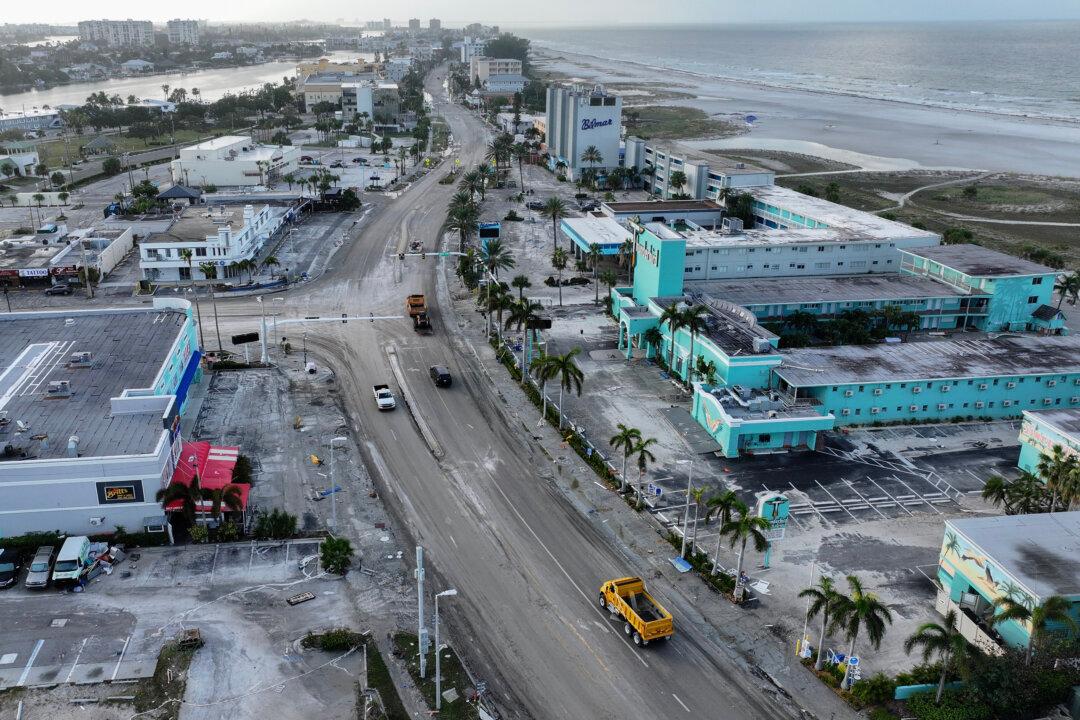At least six homes caught fire in Florida after floodwaters from Hurricane Helene submerged electric vehicle (EV) batteries and ignited them, state Chief Financial Officer and Fire Marshal Jimmy Patronis said on Oct. 2.
During a press conference with Florida Gov. Ron DeSantis in Madeira Beach, Florida, Patronis said state officials have seen 16 fires so far from EVs in the Tampa Bay area alone, including Pinellas County.
The governor had warned EV owners in Florida to get their vehicles to higher ground ahead of Helene’s arrival, as contact with saltwater can short-circuit the batteries, causing a catastrophic chain reaction known as thermal runaway in which heat energy is released from the battery to cause a fire.
“One of the threats that we’re very concerned with is lithium-ion battery technology—that’s EVs, golf carts, and scooters. These devices do not mix well with salt water,” Patronis said.
The vehicles catch fire after the short circuit spreads between multiple cells in the lithium battery, according to Tom Barth of the National Transportation Safety Board.
“If the salt water is able to bridge the gap between the positive and negative terminals of [the] battery, then it can cause a short circuit,” said Barth, who is chief of the special investigations branch of the board’s Office of Highway Safety.
The phenomenon is seemingly linked to just saltwater, as thermal runaway has not been observed in EVs from freshwater flooding in California.
When Hurricane Ian cut through Charlotte Harbor, Florida, in 2022 at Category 4 strength, with maximum sustained winds of 150 miles per hour, it sent upward of 15 feet of storm surge into portions of Charlotte, Collier, and Lee counties, compromising as many as 5,000 EV batteries and igniting 36 of them.
In that same post, Patronis included a letter from the Transportation Department’s National Highway Traffic Safety Administration (NHTSA), in which the agency confirmed that his experience in North Collier County was “not an isolated event.”
The agency stated that the first instances of EV fires caused by saltwater occurred during Hurricane Sandy in 2012, when the storm surge swamped parts of Newark, New Jersey, among other areas.
“Lithium-ion vehicle battery fires have been observed both rapidly igniting and igniting several weeks after battery damage occurred. The timing of the fire initiation is specific to the battery design, chemistry, and damage to the battery pack,” the NHTSA stated. “As with other forms of battery degradation, the time period for this transition from self-heating to fire ignition can vary greatly.”
The agency added guidance that any damaged vehicles with a lithium-ion battery should not be left inside or within 50 feet of any structure, vehicle, or combustibles.
On Sept. 30, Patronis urged any EV owners who have experienced flooding to immediately call their insurance companies and have the vehicles towed to a safe distance, especially if their power has been turned back on, which can initiate the thermal runaway process.
“That means it will burn until it doesn’t have any fuel left. You can’t put it out with water. Ultimately, that could lead to harming you, your household, or a first responder,” he said.

Even in the absence of those signs, owners are urged to call their insurance companies if water has reached the vehicle’s battery so it can undergo a safety inspection. For Tesla owners, Tesla Service will offer an inspection, and Tesla Roadside Assistance can tow the vehicle to a safe 50-foot distance away from any structures or other vehicles.







